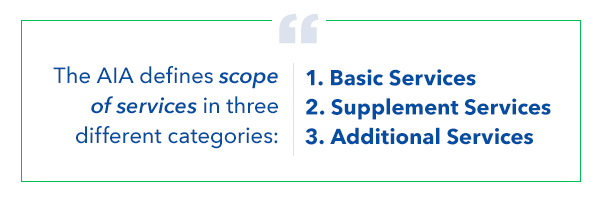Choosing a Fee Structure: 4 Things Architects Should Consider

As an architect, you’re well aware of how complex your various projects can be. You spend hours drafting designs, meeting with outside consultants and contractors, and then overseeing construction of the project itself. But one of the most important aspects of any project is determining how it will all get paid for. It’s absolutely essential that you choose a fee structure that will serve the project as best as possible, both to fit your client’s needs and to ensure your firm has ample resources to execute their vision. Here, we’ll discuss four critical things to consider when choosing a fee structure for a project.
Types of fee structures for architects
The architecture industry typically uses four distinct types of fee structures. We’ll break down each of these below:

Fixed fee
Perhaps the most common and basic form of fee structure, the fixed fee (also known as a stipulated sum fee) asks for a fixed price based on a scope and schedule of the project that is agreed upon by both parties. This fee structure is ideal if the project has a specific/tight budget, as well as a scope that can be reasonably estimated with little room for issues. Ideally, If any problems are anticipated, their costs should be included in the fixed fee price so that they can be addressed if they arise.
Of course, unanticipated issues can arise in any project, such as higher costs of materials than expected or a delay in work. Worst-case scenario, the architect will have to charge additional fees to deal with these issues (which can leave a sour taste in a client’s mouth, as they have to pay unexpected fees). In some cases, these issues may need to be paid out of the pocket of the architect.
On the other hand, a best-case scenario sees the architect completing the project at a cheaper price or a shorter amount of time, meaning the rest of the fee becomes profit for the architect.

Percentage-based fee
This structure bases its total fees on a percentage of how much the construction will ultimately cost, which is why it’s also known as Fee as a Percentage of Construction Cost. Unlike the previous structure, this fee is a bit more flexible to projects where the scope may adjust frequently, and where construction costs may be more in flux. If both client and architect understand this and agree to these terms, it can be a useful fee structure to work with.
However, some clients may be hesitant to use this fee structure, as they may feel that the architect has little incentive to keep costs as low as possible (since they stand to profit more if the cost of construction increases).
In some cases, architects will use this fee structure as a launching pad to create a more stable fixed fee structure (such as the stipulated sum fee). The artichect can use their previous experience to determine how much a certain construction job will cost and calculate the various phases of the project accordingly to reach a total that matches the client’s budget.

Time-basis fees
As the name suggests, a time-basis fee structure charges the client an agreed-upon amount based on the amount of hours the project requires to execute. This can be handled on an hourly basis or even a daily basis where the hours spent that day are tallied up and charged accordingly.
If developed correctly, an hourly fee can cover multiple aspects of the project, including overhead, profit, and labor. For example, you could start with your average labor rate, add a multiplier for overhead, as well as a multiplier for profit sharing. The totals could become the basis for your hourly rate.
However, it's important to keep in mind that not every region will have the same average rates to work off of, so the ultimate value of this fee structure may vary depending on where you’re operating from.

Unit cost
Some architects may bill their clients based on a particular unit cost, such as a dollar-per-square foot amount. However, this form of fee structure is fairly uncommon, reserved usually for very specific or complex projects.
Finding the right fee structure for you
Even with the knowledge of how each fee structure works, choosing the right one for your business is critical. More specifically, choosing the right one is often determined on a project-by-project basis. Whereas one project may work better with a fixed fee structure, another might make more sense to bill by the hour.
In some cases, you may determine that you need to employ multiple types of fee structures in order to effectively execute a project. Perhaps in one phase of the project, it would make more sense to use one form of fee structure compared to another.
In either case, developing a model that offers a great customer experience while providing [financial profitability](https://www.clientpay.com/blog/how-architects-can-increase-profitability/) to your business is worthwhile. The best way to do this is to ensure your client understands and agrees to the fee structure you intend to use before commencing work on the project.
Understanding scope of services
Another critical aspect of choosing a fee structure for a project is having a solid understanding of your scope of services. These need to be specifically defined in your project before you can properly determine how to bill for the project in general.

As of this writing, the AIA defines scope of services in three different categories: Basic Services, Supplement Services, and Additional Services.
As discussed in Article 3 of the AIA B101 Standard Form of Agreement Between Owner and Architect, Basic Services covers some of the most common phases of an architectural project, including:
- Schematic Design
- Design Development
- Construction Documents
- Procurement (formerly Bidding and Negotiation)
- Construction (commonly called Construction Administration)
Basic Services also often covers some project management details, like scheduling, permit procurement, and accounting.
Article 4 of the Standard Form of Agreement Between Owner and Architect covers Supplement Services, which, as the name suggests, are unique services that may be required outside of the standard services an architect provides. The article lists a wide ranges of services that could qualify as Supplement Services, such as:
- Programming
- Civil Engineering
- Landscape Design
- Post-Occupancy Evaluation
- Conformed Documents for Construction
- Historic Preservation
- And many more
Supplement Services can also cover services required that go beyond the standard scope of structural, mechanical, plumbing, and electrical engineers, which is often covered in Basic Services.
Distinct from Supplement Services is Additional Services, which is essentially any services that become necessary after the contract has been agreed upon and executed. These services can include the wide range of services covered in both the Basic and Supplement Service contracts.
If the architect determines that Additional Services are necessary, they are entitled to charge additional fees to accommodate them. Of course, the architect is also obligated to discuss these needs with the client, which may not be a pleasant conversation (after all, clients don’t often like to pay more than they agreed to).
It’s best to try and avoid adding Additional Services, where possible. Ideally, these needs are anticipated ahead of time and are included in the Basic and Supplement Service agreements.
Factoring in contingencies and risk
Finally, every architect should take into account the amount of risk associated with a project. Will the client’s fee adequately cover the costs of the project? Are they asking for a $10 job but only paying $5? What about the costs of consultants or other outside parties that will need to be involved? All of these need to be considered before the project gets off the ground.
Naturally, the best way to combat this is to ensure communication is open and clear between all parties involved, from the client, to your employees, as well as contractors. As you discuss the project, make sure everyone has a solid understanding of how the project will be accomplished so that expectations are clear.
However, there are some issues that simply cannot be foreseen, and extra labor (and costs) may be required. In these cases, it can be valuable to include a contingency plan. This is often accomplished by adding a contingency line in your contract with your client, where a certain portion of the budget is allocated towards unforeseen expenses. Depending on the fee structure, you might also add a percentage increase to your rates in order to compensate for these risks.

No matter which fee structure (or set of fee structures) you choose for your projects, an online payment solution can streamline your billing process by making it easy for your clients to pay as well as creating opportunities for automatic payment systems. See for yourself what an online payment solution can do for your projects by scheduling a ClientPay demo today!